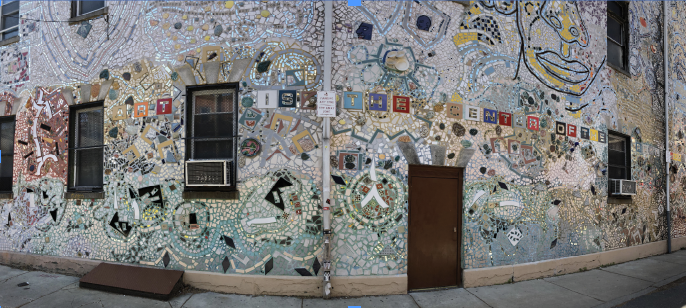A Magical Experience: Philly’s most beautiful garden
Photo Kayla Butera
Outside of Philadelphia’s Magic Gardens.
Broken green glass bottles. Deconstructed bicycle wheels. Shattered, printed plates. All layered with rough cement. From the description, this may sound like a junkyard. For locals, this is a beautifully artistic attraction: Philadelphia’s Magic Gardens (PMG).
The Magic Gardens is a nonprofit walk-in gallery, blossoming with mosaiced walls and vivid colors. Upon entering, a tiled message greets visitors: “Art is the center of the world.” In the gardens, it certainly feels that way. From antique platters to delicately painted figurines, each corner brings its own unique surprise. The maze leads admirers down a series of uneven steps to a single chair in a corner, in which three tiled faces surround it. This space is often used for private confessionals and meditation.
The Magic Gardens was created by artist Isaiah Zagar in the 1960s, when he moved to the beaten-down South Street neighborhood with his wife. Together, along with other artists and activists, they committed themselves to colorfully revitalizing the district, giving birth to the “South Street Renaissance.”
Inspired by his trips to Mexico, Zagar integrates artifacts and sculptures made by Mexican artists that mimic Latin American folk art. In one corner, a miniature version of artist Frida Kahlo graces the wall. Other works hail from India, Peru, Ecuador, Morocco, Indonesia and Guatemala. Most of Zagar’s work is spontaneous and unplanned. Visitors can spend hours contemplating the philosophical messages inscribed by the artist, like “A brief history of the future” and “Imagery which refuses to stabilize.”
In 1991, Zagar started working on vacant lots, eventually creating multi-layered walls out of recycled and cultivated objects. The community quickly fell in love with his art and its effect on surrounding businesses, but some did not see it in the same light. In 2004, the owner of the lot discovered Zagar’s project and wanted the land to be sold and his art destroyed. The community rushed to Zagar’s side, preventing the destruction of the beloved venue and instead, transforming it into the PMG site. Zagar still works on his garden and surrounding buildings to this day.
Now, PMG is open to all, hosting guided tours, field trips and even weddings. The building promotes local artists aside from Zagar, like Claes Gabriel and Andrew Chalfren, whose art contribute to the vividness of the garden. Zagar’s work is featured in institutions like the Philadelphia Museum of Art and the Pennsylvania Academy of the Fine Arts.
The PMG is a pioneer in revolutionizing a new approach to art. It is proof that rejected objects can be repurposed to make something beautiful and part of the identity of a community. While other cities are home to graffiti, it is refreshing to see artists using pre-existing materials to create an immersive form of art. Next time you’re in Philadelphia, stop by South Street to experience the magic.

